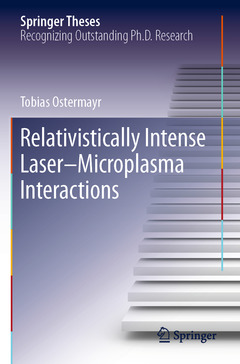Description
Relativistically Intense Laser-Microplasma Interactions, 1st ed. 2019
Springer Theses Series
Author: Ostermayr Tobias
Language: English
Subject for Relativistically Intense Laser-Microplasma Interactions:
Relativistically Intense Laser-Microplasma Interactions
Publication date: 08-2020
Support: Print on demand
Publication date: 08-2020
Support: Print on demand
Approximative price 105.49 €
In Print (Delivery period: 15 days).
Add to cart
Relativistically Intense Laser-Microplasma Interactions
Publication date: 07-2019
Support: Print on demand
Publication date: 07-2019
Support: Print on demand
Description
/li>Contents
/li>Comment
/li>
This dissertation covers several important aspects of relativistically intense laser?microplasma interactions and some potential applications. A Paul-trap based target system was developed to provide fully isolated, well defined and well positioned micro-sphere-targets for experiments with focused peta-watt laser pulses. The laser interaction turned such targets into microplasmas, emitting proton beams with kinetic energies exceeding 10 MeV. The proton beam kinetic energy spectrum and spatial distribution were tuned by variation of the acceleration mechanism, reaching from broadly distributed spectra in relatively cold plasma expansions to spectra with relative energy spread as small as 20% in spherical multi-species Coulomb explosions and in directed acceleration processes. Numerical simulations and analytical calculations support these experimental findings and show how microplasmas may be used to engineer laser-driven proton sources.
In a second effort, tungsten micro-needle-targets were used at a peta-watt laser to produce few-keV x-rays and 10-MeV-level proton beams simultaneously, both measured to have only few-µm effective source-size. This source was used to demonstrate single-shot simultaneous radiographic imaging with x-rays and protons of biological and technological samples.
Finally, the dissertation discusses future perspectives and directions for laser?microplasma interactions including non-spherical target shapes, as well as thoughts on experimental techniques and advanced quantitative image evaluation for the laser driven radiography.
Pat I: Introduction and basics.- Scientific context and motivation.- Laser-plasmas.- Part II: Experimental methods.- High-power lasers.- Transportable Paul trap for isolated micro-targets in vacuum.- Part III: Laser-microplasma interactions.- Laser-driven ion acceleration using isolated micro-sphere targets.- Laser-driven micro-source for bi-modal radiographic imaging.- Part IV: Summary and perspectives. Summary.- Challenges and Perspectives.- Part V: Appendix.
Nominated as an outstanding Ph.D. thesis by the Ludwig-Maximilians-Universität München, München, Germany
Short-listed for the DPG section AMOP dissertation prize
Comprehensive overview from technical and basic aspects to potential applications of laser–microplasma interactions
© 2024 LAVOISIER S.A.S.




